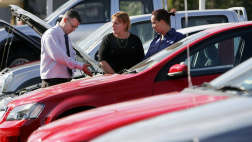The Outlander arrives with new engines, new transmissions and new trim levels but the highlight is a sleek, chiselled body that will really cut the ice compared with main rivals Honda, Toyota and Nissan.
The cabin is bigger than most rivals and detailed work to the cabin make it a very attractive proposition, especially to the mainstay female buyer group.
Outlander gets two new engines - one is it first segment foray into V6 territory, picking up a new 3-litre engine that is available in the two premium models.
The four-cylinder is a 2.4-litre but it has no relation to the outgoing engine of the same capacity.
The V6 is attached to a six-speed auto while the 2.4 gets a continuously-variable transmission (CVT) with paddle-shift manual changes as a bonus. Normally the CVT will operate as a pure auto.
Mitsubishi said that this engine mix will allow the vehicle to compete with the four cylinder rivals such as RAV4, CR-V and Nissan X-Trail, while the V6 version will go up against the Toyota Kluger, Subaru Outback, Holden Captiva and Hyundai Santa Fe.
There is also suggestions that the Outlander has the ability to lure Ford Territory buyers, specifically because of its optional seven-seat capacity - a new move for Mitsubishi in this arena.
The Outlander shows its family relationship to other Mitsubishi products with its nose, though the tail treatment is new.
It's clean and simple though distinctive on the road with a broad buyer appeal. Thankfully, the styling is a farewell wave to the freestyled, heavy grille-oriented artwork of the previous designer Olivier Boulay who also penned the last Magna.
The simplicity of the exterior continues inside. The cabin feels bigger and brighter than its four-cylinder rivals, showing excellent room for the five occupants.
The boot is big and wins extra points with its double tailgate. A low, bottom hinged gate folds down to make easy loading onto a flat cargo bed. This gate, rated at 200kg, also serves as seat.
The seven seat option adds $2800-$4800 to the price of the various five-seat models.
But while seating the seven sounds grand, the third row is made just for small kids.
All but the base model get a keyless entry and start system but all miss out on a full-size spare tyre.
On the road the Outlander feels more confident than its predecessor.
The longer wheelbase and wider track give better stability and cornering precision, though that improvement is countered by some steering wheel vagueness.
Only the four cylinder variants were driven and, hence, only the CVT box. Initially impressive for its simplicity of driving, there were times when the 2.4-litre engine - even with variable-valve timing - struggled to get the power quickly to the ground.
It could also be noisy when the right foot pressed hard. But the CVT won back points for its quietness and low-speed engine revs that improved fuel economy.
For those seeking performance, the manual version looks a better bet and will hit here next year at an expected $29,990.





.jpg)
.jpg)

.jpg)
_0.jpg)


.jpg)




.jpg)
.jpg)




.jpg)
.jpg)




